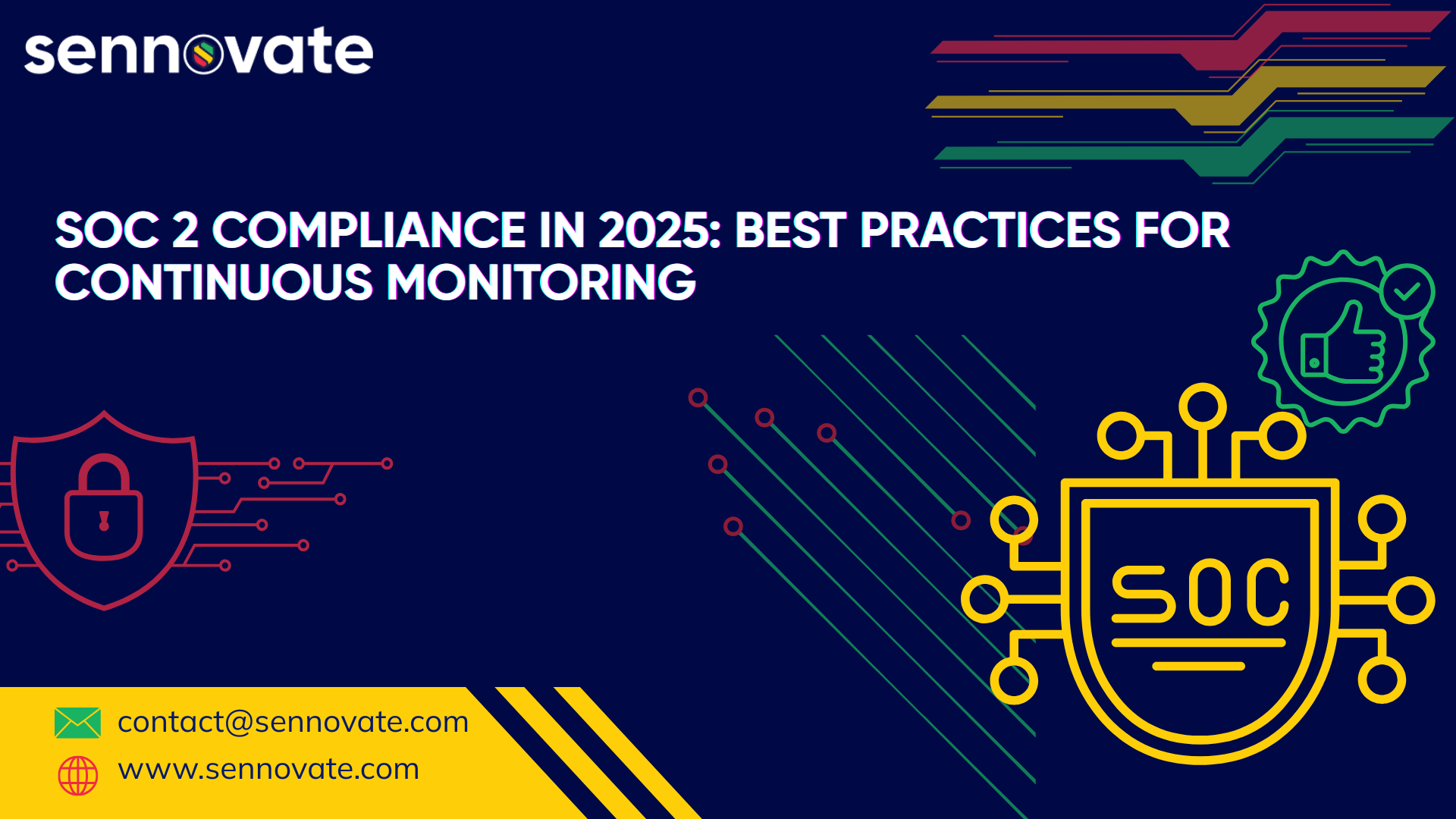

SOC 2 Compliance in 2025: Best Practices for Continuous Monitoring
In the current threat environment, SOC 2 compliance has transitioned from a one-time audit to a continuous security necessity. Given that 93% of cloud breaches are associated with misconfigured controls (Gartner 2024) and the rise of new AI-driven threats, organizations are required to implement ongoing monitoring strategies to uphold compliance and avert breaches.
This guide examines:
✔ The evolution of SOC 2 in 2025
✔ Major challenges in maintaining continuous compliance
✔ Best practices for automated monitoring
✔ How Sennovate’s cybersecurity services in the USA facilitate SOC 2 compliance
1. Why SOC 2 Compliance is Changing in 2025
New Trust Services Criteria (TSC) Updates
The AICPA’s 2025 guidelines introduce:
- AI Governance Controls (for machine learning systems handling client data)
- Third-Party Risk Scoring (mandatory vendor monitoring)
- Real-Time Incident Reporting (72-hour breach disclosure)
📌 Impact: SOC 2 Type II reports now require monthly control testing (vs. annual).
Rising Cyber Threats Driving Stricter Requirements
| Threat | SOC 2 Control Update |
| AI-Powered Attacks | New AI logging/monitoring requirements |
| Cloud Misconfigurations | Automated CSPM (Cloud Security Posture Management) checks |
| Supply Chain Attacks | Vendor SOC 2 reports must be ≤90 days old |
2. The 5 Trust Service Principles & Continuous Monitoring
1. Security (Mandatory)
Best Practice: Implement SIEM + EDR with round-the-clock threat detection
Tool Example: Microsoft Sentinel + CrowdStrike
2. Availability
New 2025 Regulation: ≥99.99% uptime verification for essential systems
Solution: Quarterly automated failover testing
3. Processing Integrity
Update: AI-based anomaly detection within data pipelines
4. Confidentiality
Significant Change: Quantum-resistant encryption for “Restricted” information
5. Privacy
GDPR Intersection: It is now necessary to map all PII flows for DSAR compliance
📌 Statistic: 68% of SOC 2 audits do not succeed due to insufficient monitoring evidence (AICPA 2024).
3. Top 5 Continuous Monitoring Challenges
1. Alert Fatigue
Problem: Teams overlook 70% of alerts (Ponemon)
Fix: AI-driven alert prioritization
2. Multi-Cloud Complexity
Issue: AWS/Azure/GCP each necessitate distinct controls
Solution: Unified CNAPP (Cloud-Native Application Protection Platform)
3. Vendor Risk Visibility
2025 Requirement: Ongoing vendor SOC 2 scorecards
Tool: SecurityScorecard or BitSight
4. Employee Non-Compliance
Data: 54% of breaches stem from human error (Verizon DBIR)
Fix: Automated policy enforcement (e.g., Netskope DLP)
5. Evidence Collection
Pain Point: Manual spreadsheets consume 200+ hours per audit
Automation: Drata, Vanta, or SecureFrame
4. SOC 2 Continuous Monitoring Framework
Step 1: Control Automation
Tools: Terraform for IaC security, Wiz for cloud monitoring
Example: Auto-remediate public S3 buckets within 1 hour
Step 2: Real-Time Logging
Must-Have: Immutable logs with SIEM correlation
Compliance Tip: Retain logs for 7+ years (new AICPA guidance)
Step 3: AI-Powered Threat Detection
Use Case: Darktrace identifies novel attack paths
Cost Saver: Reduces breach investigation time by 80%
Step 4: Automated Reporting
Template: Monthly SOC 2 readiness reports for auditors
Key Metric: % of controls passing daily tests
5. How Sennovate Simplifies SOC 2 in 2025
As a premier cybersecurity services provider in the USA, we offer:
🔹 SOC 2 Readiness Assessments
- Gap analysis against 2025 criteria
- Customized roadmap
🔹 Managed Continuous Monitoring
- 24/7 control validation
- AI-driven anomaly detection
🔹 Audit-Ready Automation
- Pre-built policies for AWS/Azure/GCP
- Instant evidence generation
🔹 Employee Training
- Phishing simulations
- Policy attestation workflows
📞 Get SOC 2 Compliant Faster → [email protected]
SOC 2 as a Security Advantage
With continuous monitoring now obligatory, SOC 2 compliance serves as:
✔ A competitive differentiator (72% of enterprises demand vendor SOC 2)
✔ A breach prevention tool (Reduces incident costs by $1.2M on average)



